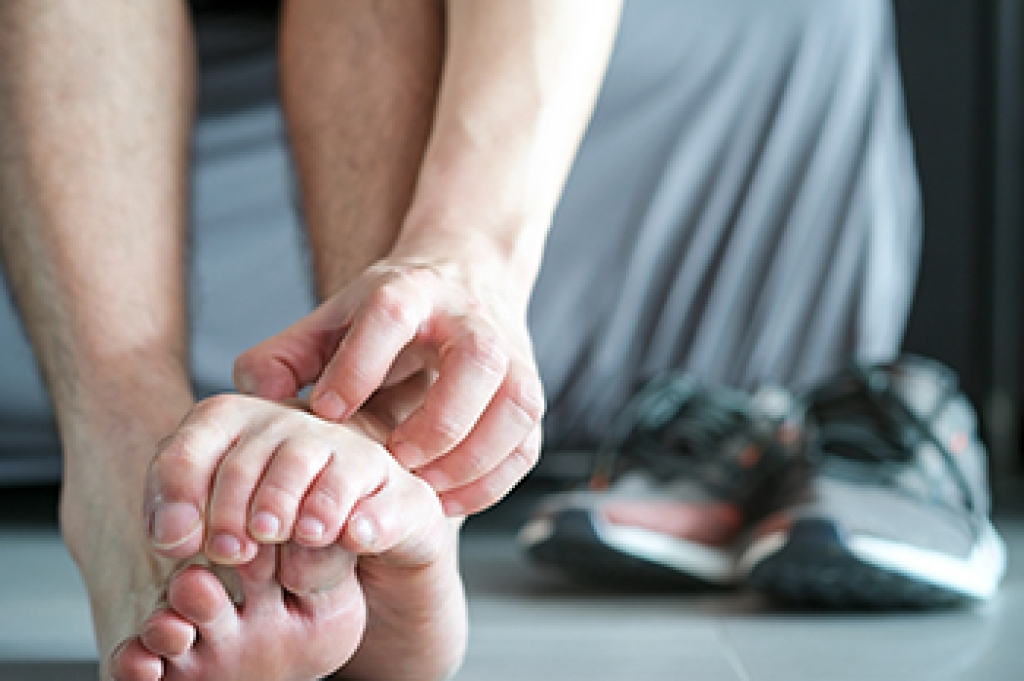 Athlete’s foot is a fungal infection on the feet that causes a red, scaly and itchy rash between the toes. The skin may form blisters, as well as crack and peel. The fungus that causes Athlete’s foot is very contagious and thrives in warm and moist environments like showers, locker rooms and pools. It often spreads from the floors, towels, or clothing. Athlete’s foot can spread around the feet as well. If it isn’t treated properly, Athlete’s foot can spread to the toenails, causing them to be thick and discolored, and it can spread to the hands if touched. Patients who believe that they have Athlete’s foot should make sure to keep their feet dry and not share any common items like shoes, socks and towels because of how contagious it is. Patients who believe that they have Athlete’s foot should consult with a podiatrist for a proper diagnosis and treatment path.
Athlete’s foot is a fungal infection on the feet that causes a red, scaly and itchy rash between the toes. The skin may form blisters, as well as crack and peel. The fungus that causes Athlete’s foot is very contagious and thrives in warm and moist environments like showers, locker rooms and pools. It often spreads from the floors, towels, or clothing. Athlete’s foot can spread around the feet as well. If it isn’t treated properly, Athlete’s foot can spread to the toenails, causing them to be thick and discolored, and it can spread to the hands if touched. Patients who believe that they have Athlete’s foot should make sure to keep their feet dry and not share any common items like shoes, socks and towels because of how contagious it is. Patients who believe that they have Athlete’s foot should consult with a podiatrist for a proper diagnosis and treatment path.
Athlete’s Foot
Athlete’s foot is often an uncomfortable condition to experience. Thankfully, podiatrists specialize in treating athlete’s foot and offer the best treatment options. If you have any questions about athlete’s foot, consult with Dr. Castillo from Bronx Foot Care. Our doctor will assess your condition and provide you with quality treatment.
What Is Athlete’s Foot?
Tinea pedis, more commonly known as athlete’s foot, is a non-serious and common fungal infection of the foot. Athlete’s foot is contagious and can be contracted by touching someone who has it or infected surfaces. The most common places contaminated by it are public showers, locker rooms, and swimming pools. Once contracted, it grows on feet that are left inside moist, dark, and warm shoes and socks.
Prevention
The most effective ways to prevent athlete’s foot include:
- Thoroughly washing and drying feet
- Avoid going barefoot in locker rooms and public showers
- Using shower shoes in public showers
- Wearing socks that allow the feet to breathe
- Changing socks and shoes frequently if you sweat a lot
Symptoms
Athlete’s foot initially occurs as a rash between the toes. However, if left undiagnosed, it can spread to the sides and bottom of the feet, toenails, and if touched by hand, the hands themselves. Symptoms include:
- Redness
- Burning
- Itching
- Scaly and peeling skin
Diagnosis and Treatment
Diagnosis is quick and easy. Skin samples will be taken and either viewed under a microscope or sent to a lab for testing. Sometimes, a podiatrist can diagnose it based on simply looking at it. Once confirmed, treatment options include oral and topical antifungal medications.
If you have any questions, please feel free to contact our offices located in Bronx, NY Yonkers, NY . We offer the newest diagnostic and treatment technologies for all your foot care needs.
